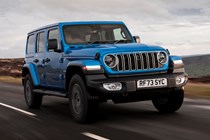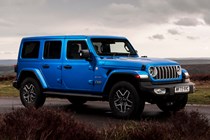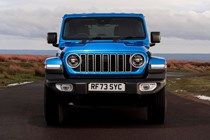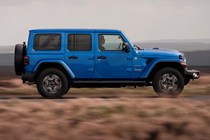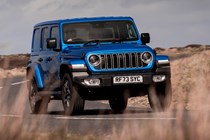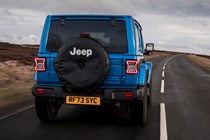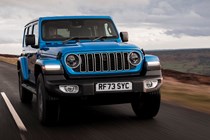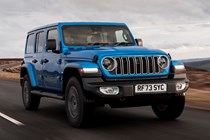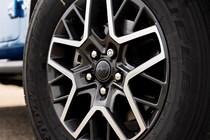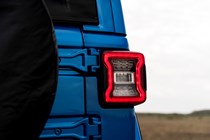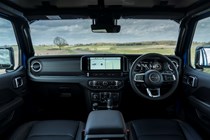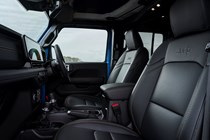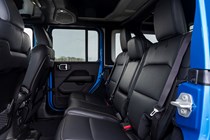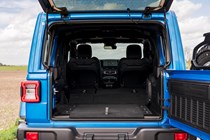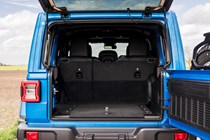Jeep Wrangler long-term test

For American off-road fans, the Jeep is considered a way of life – but in the UK there’s a distinct absence of rocky deserts, endless dirt roads and nature reserves to roam in, so what’s the Jeep Wrangler for? Richard Kilpatrick finds out…
Unusually for a Parkers long-term report, this covers a wide variety of Jeep Wranglers – from the original 2018 two-door diesel Sahara, to the 2020 Wrangler Unlimited Night Eagle with Sky One-Touch roof and turbo petrol engine.
You can skip to the model you’re interested in, below, or read the whole report for an overview and comparison.
Update 1: Long short-termer (diesel Wrangler Unlimited Overland)
Update 2: Short long-termer (diesel Wrangler Sahara two-door)
Update 3: Defender vs Wrangler
Update 4: That’s not my Jeep! (petrol Wrangler Unlimited with Sky roof)
Update 5: Petrol vs diesel
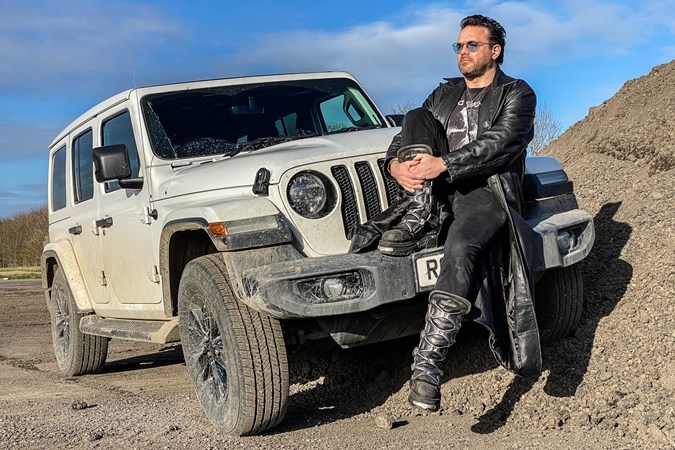
One thing unites the entire Jeep Wrangler range, and that’s a true sense of adventure and a character unlike any other car you can buy new in this budget.
Update 1: Long short-termer
If you’re reading this long-term report expecting a very Parkers, unbiased, objective summary of whether a £48,000 Jeep Wrangler makes more sense than a Nissan Qashqai – sorry.
You already know, I already know, even small green aliens from Alpha Centauri know; a Jeep Wrangler is utterly ridiculous for day-to-day driving in Britain.
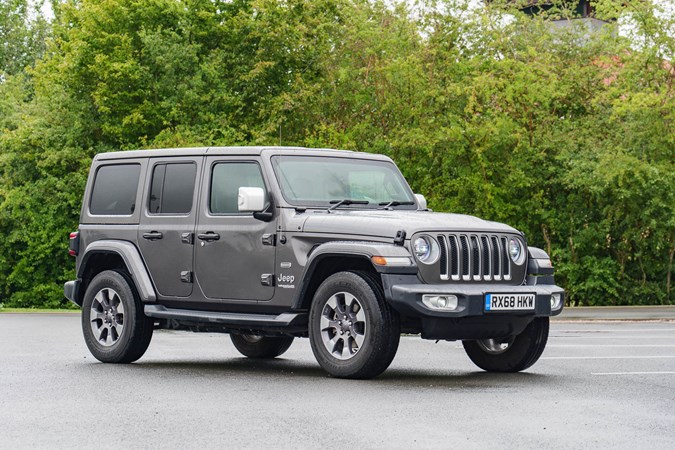
I’d even go so far as to suggest the Qashqai is ‘a bit much’, and we’d probably all be happier driving a nice little VW Up and swapping into a van for trips to IKEA, or a rented Volvo S90 for long motorway hauls, but you want a Qashqai becuase it’s a bit SUV-ish and looks handsome on your drive, and I want a Jeep because it looks like it escaped a movie set and is made out of things you can fix with a large hammer. Or a torx set.
A Jeep Wrangler isn’t about objectivity. It’s about emotion, about a passion for adventures or engineering, about history, about style. As you rightly guess, I’m already a big fan of 4x4s and Jeeps in particular, so this long-term test is really about whether or not the Jeep delivers on the promises it makes for that quite substantial price tag.
Starting at over £41,000 for a basic two-door Sport, rising to over £50,000 for a four-door Rubicon, the Jeep Wrangler has few direct rivals and many alternatives. For off-road prowess, you could choose anything from a Ford Ranger Raptor/Isuzu D-Max XTR to a Foers Ibex; including the sensible options of Toyota Land Cruiser or Mitsubishi Shogun Sport.
For open-air motoring and silliness – Caterham, Morgan, Ariel plus countless more conventional options. For rugged, boxy practicality, a Vauxhall Combo 4x4?

Nothing on the UK market blends all of these things into one car, though. The Jeep’s only real rival (and even then, the roof doesn’t come off) is a used Mercedes G-Wagen. For the cost of a new top-spec Wrangler you’ll get a six year old diesel G-wagen, or ten-year old V8 AMG model with almost 100,000 miles on it and probably, pimped out to near-nauseating levels of poor taste. The Jeep looks very appealing in such company.
And yes, if you want to know what it’s like to live with a Jeep even if you don’t want one, we’ll cover that too – but for fairness, understand that I’m biased. You need to be to even consider this thing a rational choice.
Intro: ‘my’ Jeep.
Given the relatively small cost difference between the higher specifications, I’d always pick the Rubicon; the upgrades are good value (and fully warranted and tested) compared to aftermarket equivalents, and it’s the Jeepiest Jeep there is. However, what was available was an Overland, which is the top-spec of road-biased Wrangler.
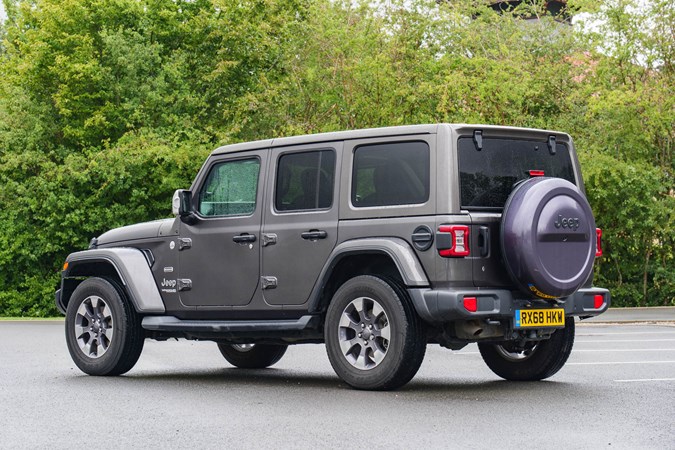
Due to the pandemic, the loan period (and pool of cars) was somewhat changed, meaning FCA (Jeep’s parent company, about to merge with PSA) have to substitute the sensible four-door Overland for a two-door Sahara (with options), both in Granite Crystal grey.
I wouldn’t choose this colour myself, as I think the Jeep’s size, structure and contrasting black plastic elements look best against bold colours – but there’s a subtle maturity to the long-wheelbase four-door one and it’s really grown on me.
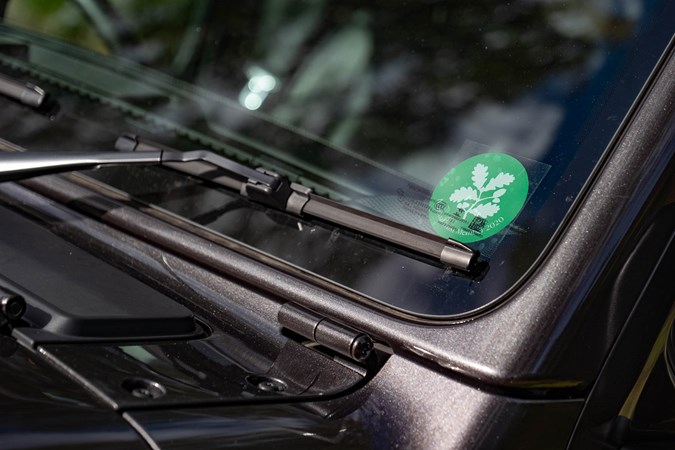
Both are specified with the 2.2-litre diesel, which provides acceptable performance, surprisingly good refinement (it’s a little clattery at idle, but not unduly so) and reasonable economy given even the smaller Jeep is a two-tonne truck.
And that’s after the weight reduction for the JL-series, which uses more plastic and alumin(i)um parts in the body.
First impressions of a used Wrangler Unlimited
You can consider these ‘used’ tests – the four-door Jeep has 15,000 miles on it, the same as my previous long-term C-Class Cabriolet – but they’re not ‘approved-used’ cars, they’re press loan vehicles and they’ve been put through the full gamut of on-road, off-road, test-day abuse before I took the wheel. One careful owner they are not, so any issues with build quality are sure to be revealed here.
With just two weeks to enjoy the four-door, it’s been on one trip to Scotland and a couple of trips to Peterborough for shooting test cars – where the ability to remove the roof is very useful for getting a bit of height for roadside shots. Previously I’ve used roofracks and ladders on 4x4s as a platform; it’s one of the advantages of a vehicle like this.
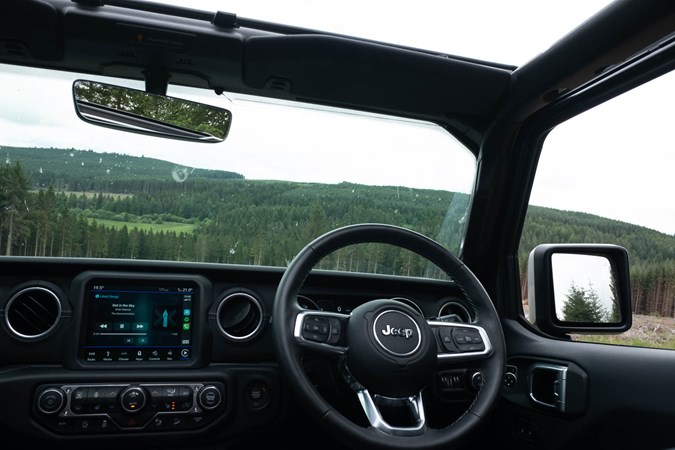
Over that time, it’s returned 36mpg (motorways, cities and a very small amount of off-road), and proved comfortable enough on 10-hour round trips – you can read more detail about what the Wrangler’s like there in the main review. It’s also made me a little concerned about my actual long-termer’s usefulness, as the four-door’s seats fold flat into the floor, adding to a decent boot, where the two-door has tumble-forward ones and no boot to speak of.
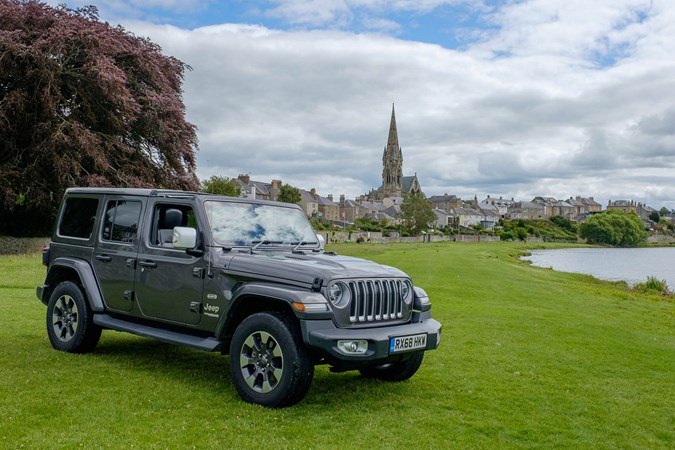
There’s a pleasing absence of unexpected noise from the trim, or wear in the suspension, despite the miles (and use), and the interior arguably shows less wear than my Mercedes did at the same age. Setting off at 8am from the Midlands means lunch in Scotland is possible, comfortable and not stressful, at least with the road-biased Overland trim.
The original convertible SUV isn’t really a convertible
No matter which Wrangler you choose (Unlimited is the name for the four-door) they all come with a three-piece ‘Freedom Top’ in the UK. This hardtop can be unbolted (as can the doors and windscreen), but in reality it’s a big sunroof for the front and a secure roof for the back, unless you’re really into getting rained on or unbolting things often.
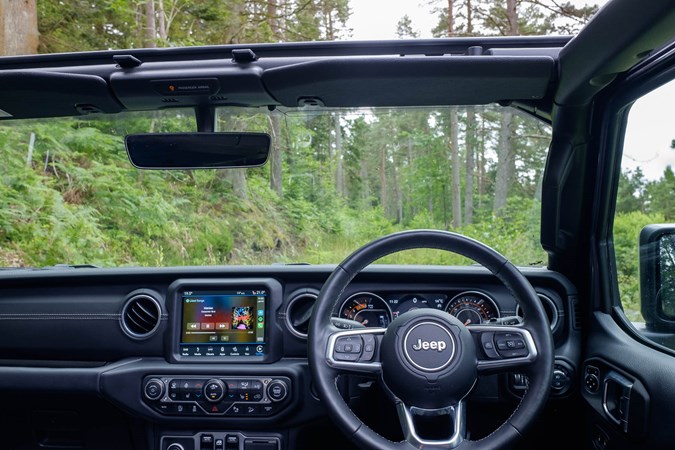
Soft-top options are available, but in Britain if you want a convertible Jeep, you’ll need to shell out for an extra roof from Mopar or an aftermarket supplier. Frustratingly, this means you can’t get the most sensible open-air option, the full-length electric sunroof hardtop on older models – it only joined the range in 2020. Americans may have garages – we Brits have sheds, and they’re usually not big enough to store the roof of a Jeep in.
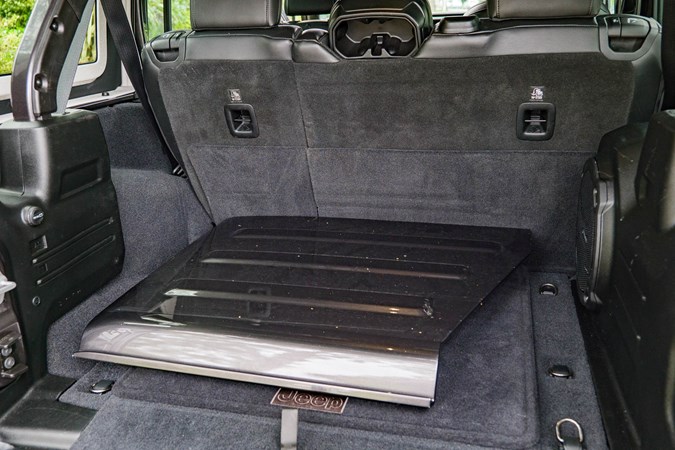
Even then, storage of just the front panels on the go could present a problem. They’re huge, and on higher-spec ones, painted so easily marked, but there’s no dedicated holder for them. The two-door car comes with a bag, and you can get quick sunshade-like tops, but it’s also worth noting that for other markets some four-door Wranglers feature a five-piece top so the passengers can enjoy sunshine too, and the front panels on that version are more compact.
As a four-door, practical car with a large front sunroof the Wrangler Unlimited requires surprisingly few compromises for daily duties, though. The name suggests that the two-door Wrangler may, in fact, be limited…
Update 2 (door): four doors good, two doors better?
An Orwellian shift in Jeeps…
There’s a theme here. Two seems to be the magic number, as two weeks after taking delivery of the Wrangler Unlimited, it was taken away by two socially-distanced professional drivers, leaving a two-door Wrangler Sahara in its place.
From this:
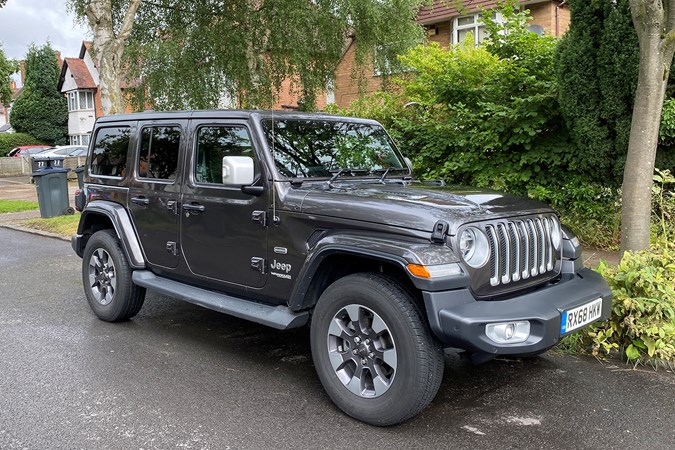
To this:
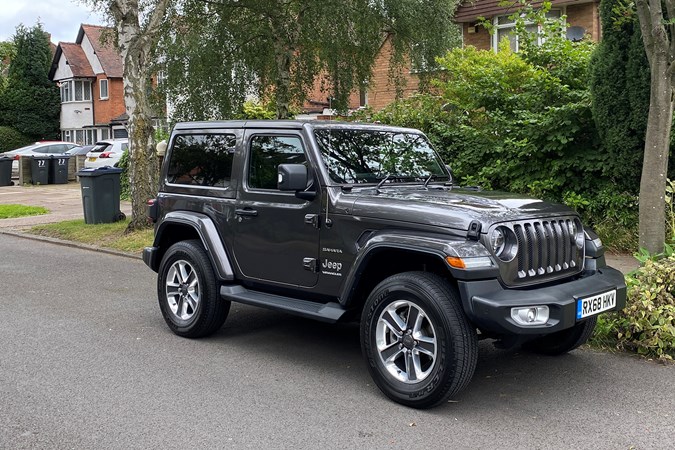
The rather disconcerting feel of two such similar, yet different vehicles is compounded by the fact that the Sahara is the same shade of grey, has a similar numberplate, and even has the leather interior of the Overland (an option well worth having).
Where the Wrangler Unlimited aims to be an uncompromising, family-friendly 4x4 for people who have had to compromise between ‘leisure driving and hobbies’ and ‘real-world practical needs’, the Wrangler two-door is a veritable smorgasbord of compromises made for people who are uncompromising in their pursuit of off-road, lifestyle driving.
Roads? Where we’re going, we don’t need roads. Or luggage space.
Handily, the two-door model came with the proper bag for the roof panels. This is a well-designed, but slightly fiddly zip-up backpack for the rear seat, with foam inserts to keep the painted panels apart – aside from some arguing with the zip, it’s easy to use, securely attaches to the headrests and boot floor load retainers, and takes up the entire boot.
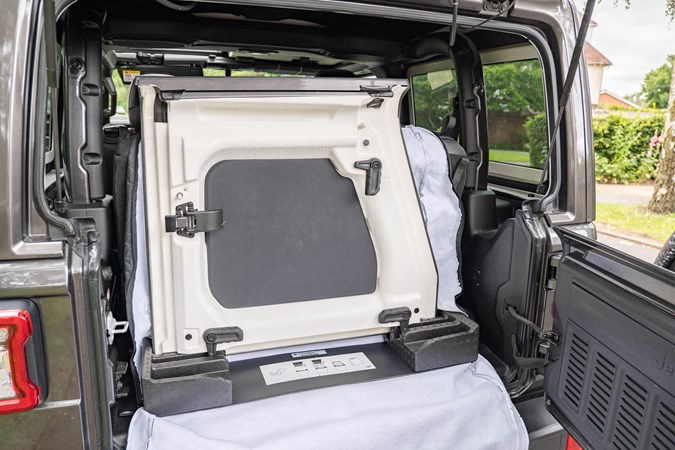
It also takes most of the view out of the back window. But that’s okay, you’re driving a Jeep – you only need to see where you’re going, man, not where you’ve been,
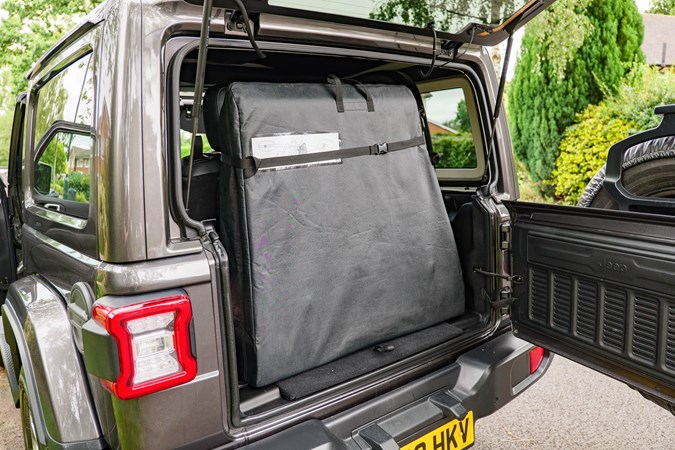
While we’re on the subject of seeing where you’re going…
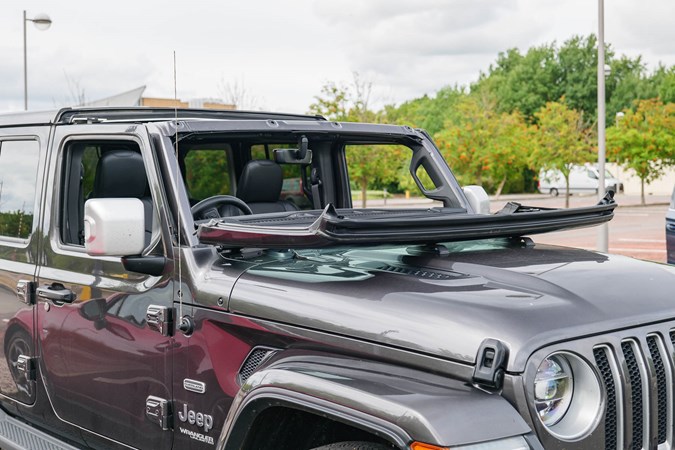
Folding the windscreen requires removal of the wiper arms and four torx bolts in the header rail; the tools do do it are provided and it’s very quick, but you’ll want the optional retaining straps to drive like this. I’d like to see a quick-release system for off-road driving where you could secure the windscreen to the header rail with catches for most of the course, then uncatch and lower it for tricky sections, but the bulk of the frame does reduce the appeal compared to a classic Jeep or Land Rover going screenless.
Still, it’s a great touch from Jeep – awesome for lamping (hunting with lamps), if that’s your thing. It helps that the bumper’s big enough to hold a muntjac, too (some might argue it’s big enough to hold a moose) – though poachers can forget sneaking about in a two-door, you’ve nowhere to hide things unless you’re going to tuck a salmon in the spare wheel cover.
Not planning on going off killing wildlife for sport? The flip-down windscreen is also ideal for our post-pandemic world of drive-in events. Just don’t forget your mask.
Realistically, there are plenty of amazing places to drive your Jeep – join the Green Laning Association to learn where and how to drive your 4x4 in the countryside responsibly. We’ll be taking a look at some routes that are suitable for most popular SUVs as well as more serious 4x4s in future updates.
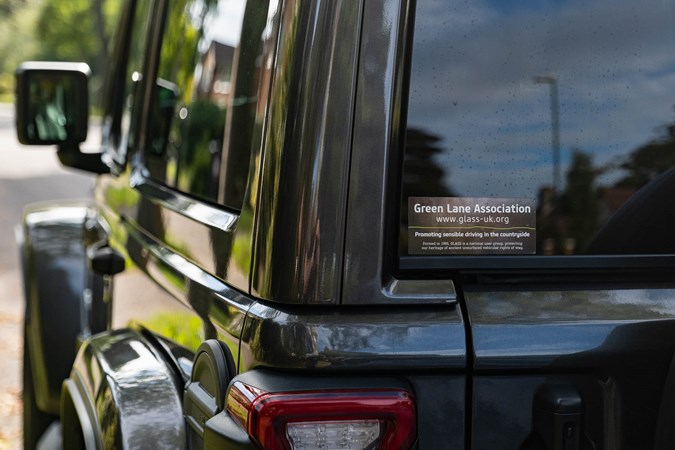
Two doors good, two seats better
We know the two-door Jeep is the purest form of Wrangler, and really, the compromises are very few in UK-specification Sahara (the mid-range level, there’s a Sport below, and the Rubicon or Overland range-toppers for road or off-road perfection above). By far the most obvious issue is the need to carry four people, which in a vehicle this short means there’s no boot space.
This is easily resolved if you’re alone or just with one passenger, as the seat can be tumbled forward and secured with straps as a small, but very thick, bulkhead – or better yet, removed entirely. My first thought was ‘what am I going to do with this seat’, and the second was ‘I could make a base for it and use it as a sofa’; of course, someone’s already done that…
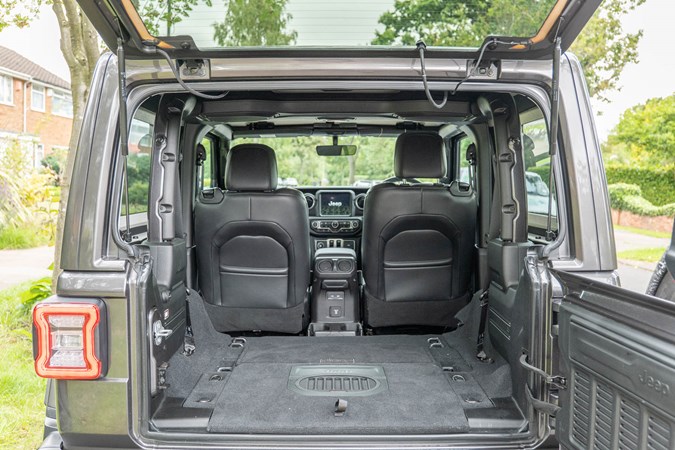
With the seat removed there’s a practical, large load area behind the front seats – you can recline the passenger front seat back down to get long loads in, but it doesn’t recline very far, so it’s easier to slide it back and use the footwell – and aside from loading up the back blocking the subwoofer (on the two-door, it occupies the space in the boot floor where the four-door has storage and a subwoofer to the side) it’s a really practical load carrier for two people and a load of camping, hunting, fishing or sports gear.
In this form, you can pop your roof panel bag to one side, tying it to the roll bars. Once again, the fact that UK Jeeps tend to be marketed with the hardtop is infuriating but probably keeps insurance down – a committed Jeeper will want to hand over the roughly £1,500 needed to put a proper soft roof on to get the full out-in-the-wild experience.
There are many aftermarket solutions for storage – Amazon US shows the true expanse, but a few companies offer the rollbar bags and tailgate organisers in the UK.
For comparison, here’s the boot space of the Wrangler Unlimited with the seats up, compared with what you can have in a two-door Wrangler without removing any seats…

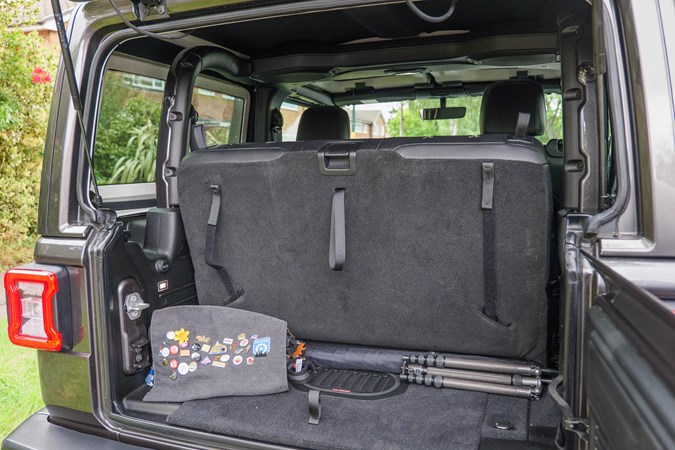
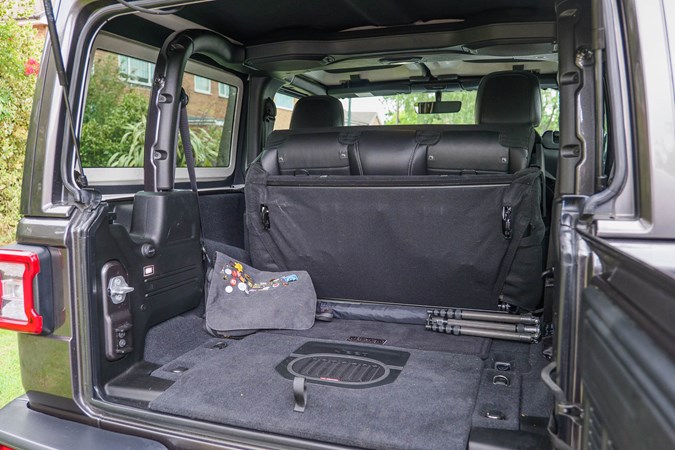
All seats are equal, but some are more equal than others
Perhaps the biggest shock in the Wrangler – of any level – is the lack of electric seats on a £50K car. You’ve got to move bits of plastic and metal around to adjust the seats. Not many bits, either – the driver’s seat has fore-aft, backrest recline (with a pull tab to release the latch, not a rotary control), height and lumbar support. The passenger has fore-aft and recline only, and the rear passengers have seats – no recline, despite the open space of the Jeep. But the space available to all is quite equal, in that rear passengers in a two-door Jeep feel quite boxed in, and front passengers also feel quite boxed in by the small footwells and close pillars.
Drivers don’t care as a rule, because they’re driving, but even then the Wrangler’s footwells have quite a big intrusion on the left, where your clutch foot would normally rest on a manual – even on an auto, there’s no easy place for normal adults to rest their spare foot, and the long wires in braided surrounds for the door wiring can nibble passenger’s calves without the focus of pedals to press.
Shorty’s got the moves – rather a lot of moves
Swapping straight into the short wheelbase Wrangler from the Unlimited, there’s a marked difference in handling. This one has 12,000 miles on it, but feels less planted and there’s far more movement of the body in reaction to road surface imperfections. In town, it’s a non-stop stream of information, ajustment, more information, and you’re grateful in poor weather for the JL Wrangler’s permanent 4x4 option. It may be placebo effect, but I felt that the Wrangler two-door handled motorway slip roads, roundabouts and twisty roads better with all-wheel drive on, even in conditions where you wouldn’t normally bother.
It’s not that odd – my 1998 Cherokee was much the same, but then it had a ferocious 4.0-litre straight-six and less technology stopping the wheels from spinning. They share the same solid beam axles, steering architecture and track bar concept as well – though the Wrangler bits look meatier than I remember on the Cherokee.
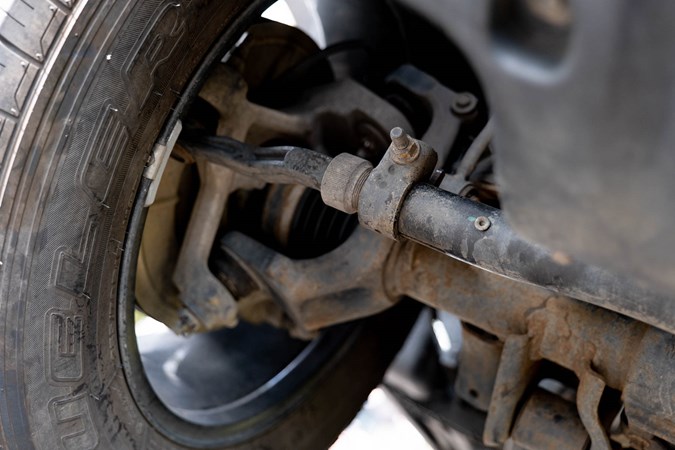
From the driver’s seat it’s entertaining, exciting, you feel involved and in control. Passengers get less out of it, and unless you’ve got someone who loves to be driven in that passenger seat, expect complaints – moreso than you’d get in the long wheelbase Unlimited, and I’d wager more than you’d get in a short wheelbase Land Cruiser.
Again, that removable roof makes all the difference here – where the Land Cruiser may as well be a tall, wobbly Yaris, the Jeep is an experience, an identity and a lifestyle statement as well as a thoroughly competent off-roader.
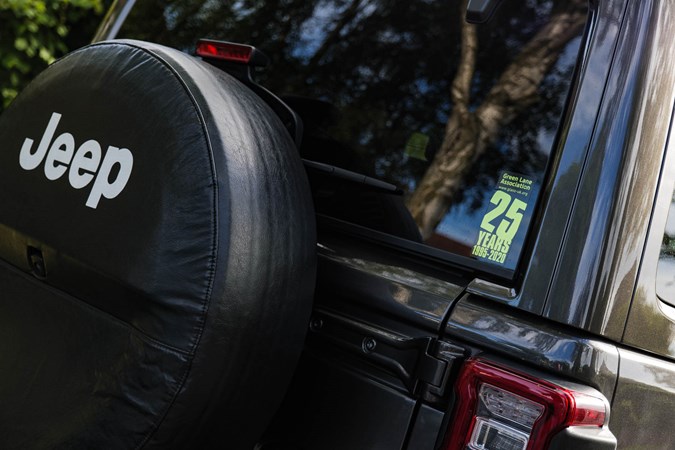
On-road it’s a different matter – for an objective take, read the full review, but as a 4x4 enthusiast I find the short wheelbase Wrangler rides pretty well for a car with solid axles at either end, is responsive and most importantly, brakes predictably and safely even at legal maximum speeds. I really enjoy driving it, but it’s a moshpit, not an opera.
The four-door is more stable, relaxing and comfortable and that’s the one you should choose as a practical, everyday, long distance and family car, though; the two door’s advantages off-road are marginal compared to the disadvantages on-road and at IKEA (other sources of impractically-large but often-bought items are available).
Update 3: ‘Wouldn’t you rather have a Defender than a Wrangler?’
Lockdown. House moves. Chaos. Li’l Bear, as I’ve named the Wrangler, has just clicked over 16,000 miles and at the time of writing, completed a 750-mile round trip in a weekend visiting family and collecting old typewriters from remote bits of Wales.
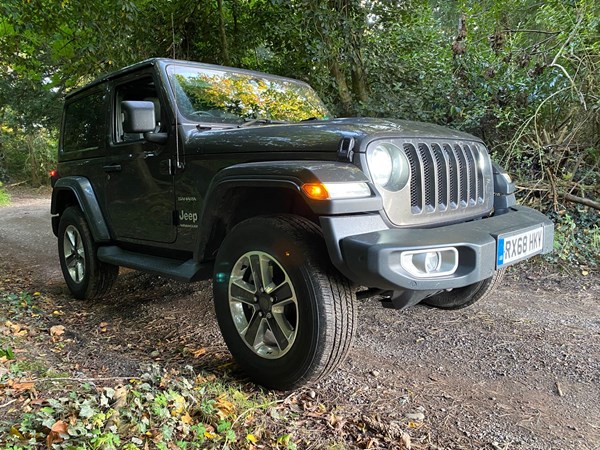
Three ‘countries’ in 36 hours, starting from a pretty eastern bit of the UK, it’s performed admirably – but cars are better suited to that sort of slog.
In fact, there are better 4x4s for that kind of motorway hauling too.
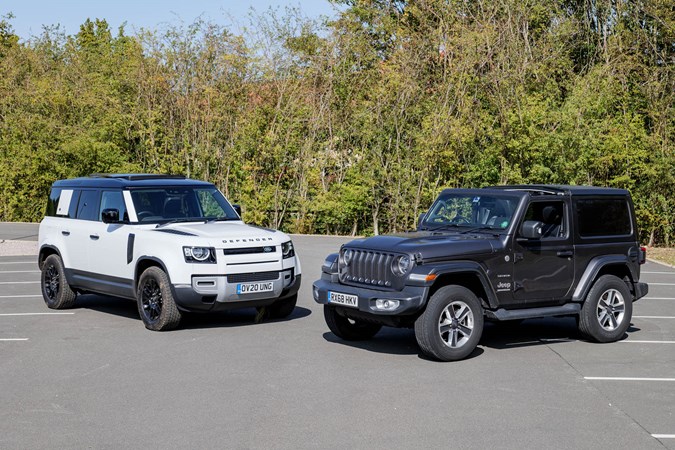
Running a ‘proper Jeep’ means you’re frequently having to explain why. In some ways, it’s easy – there simply aren’t many options for an old-school, solid-axle, body-on-chassis type 4x4 now. Used cars exist of course, and the improvements made to the JL Wrangler mean a secondhand, previous-generation JK is a very different prospect indeed, but compared to the same money spent on an old-school Land Rover Defender, the Jeep’s just vastly better value overall. And a lot nicer to drive.
But wait. There’s a new Land Rover Defender. It has nothing in common with the Jeep or the old Defender, being based on a fully-integrated body and chassis with independent suspension and no unboltable bits, but for the majority of drivers those things don’t matter.
In Hard Top Commercial form it’s a potential rival to the two-door Wrangler Sport (as discussed above, the rear seats in the two door Wrangler are a thing you fit when you need them, rather than fold away when you don’t), but we got a Defender 110 in civilian-spec for review so I stole it for a weekend while senior staff writer Lawrence Cheung, who knows a fair bit about Land Rovers, borrowed the Wrangler.
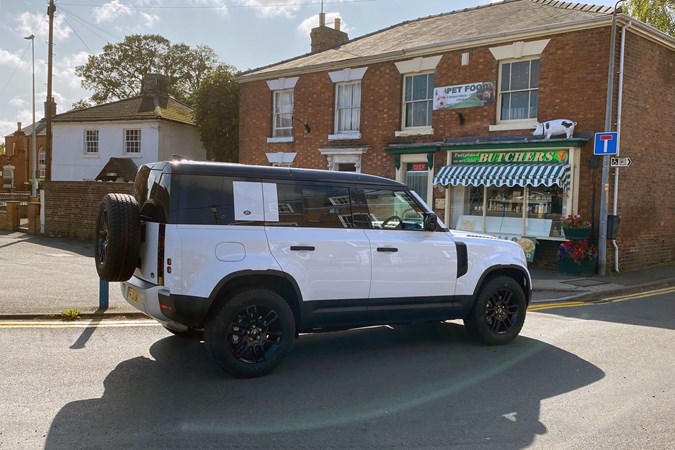
Enter the Defender – £59,000-worth of air-suspended luxury
So our test Defender isn’t what I’d choose – for a start, it’s almost £10,000 more than the most expensive four-door Wrangler, so it’s a little unfair. However, the core elements are what counts, so here’s what we’ve got.
>> 240hp four-cylinder diesel engine – this will be upgraded to a six-cylinder mild-hybrid very soon, so if you’re reading this in the future that may not be relevant.
>> Air suspension with adjustable ground clearance.
>> A large panoramic sunroof (instead of a large set of fibreglass bits you can remove).
>> Lots of fancy driver assistance and all-around view cameras.
>> A Land Rover badge, which in the UK has more cachet than even a trail-rated Jeep.
>> Some soft leather-feeling bits.
>> The worst headlights this side of an original Series II. The kind of Land Rover with the lights in the grille. Yes. Basically a tractor with candles.
That last point really surprised me. They’re perfectly good on full bream, but dipped beam slices off the corners and dog-ears visibility so any gatepost, awkward bend or driveway becomes a guessing game; there are no cornering lights to fill in the gaps, either. Why, Land Rover, why?
What I like about the Defender:
The looks are absolutely spot on. There isn’t an angle on the Defender (and it has many of them) that I don’t like, from the shape of the wheelarches to the abrupt tail and alpine windows – in short, the outside blends all those classic Land Rover cues found on the original Series with the Judge Dredd era of styling.

The interior is a thing of wonder to me. The dashboard is still ‘too much dash’ with the windscreen too far away, but it’s better than most modern cars. Handles either end of the dashboard and a floating display that evoques the idea that someone balanced an iPad in the middle of a 110 County’s rudimentary trim is pretty much spot on, though I’d have loved some mesh vents for the full effect.
Details that I really liked included bare metal on the doors, the Defender script on the dash, the contrasting black & white steering wheel and the checkerplate floor in the back (though it’s very slippery).
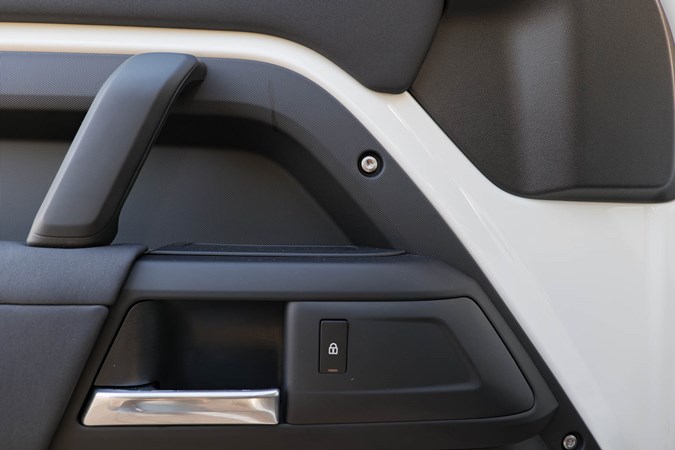
Compared to the Jeep the driving position is fantastic. The cabin is much wider (three-abreast in some models) so it stands to reason, but being freed of the Wrangler’s cramped footwell is very pleasant.
The power is seamless, and catches you off-guard because the Defender is so very refined by comparison with most 4x4s or pickups. The Ingenium engine isn’t something you’ll be playing back recordings off (neither is the Wrangler’s diesel) but its clatter is remote and unintrusive. Unlike the speed, when you realise this behemoth is rapidly heading for the speed limit without drama; it’s almost too easy to let the pace increase on-road.
Immensely-powerful brakes inspire confidence compared to other 4x4s, too. Relevant to the way it gathers speed.
It’s crazy-luxurious, but then for £59,000, I would hope so.
Generally, I think they’ve got the interior design, feel, materials and attitude perfect. Top marks to Land Rover for updating the Defender and keeping the Defender name honoured with an excellent SUV.
Wait. You said SUV, not 4x4… what gives?
What I don’t like about the Defender.
Top of the list is the air suspension. Sorry – I understand all the benefits, and as a fan of old-school Citroens a floaty ride is a bonus, not a negative, but if the Wrangler is like a truck on a pogo stick, the Defender is a bouncy castle that’s an actual castle. On motorways it’s excellent, but on corrugated, unpredictable fenland roads it’s laggy, unpredictable and slows you down without actually isolating you – it’s partly that the bounce happens after the rut, where the Wrangler tosses you around in time with the ridges and you get into the rhythm.
Despite being the driver (and only person in it!) it induced a bit of nausea at perfectly reasonable speeds, such was the constant side-to-side, occasionally diagonal movement of the waterbed ride.
Exacerbating the feeling of directional instability on such roads, the visibility is pretty poor. The pillars are thick, the windscreen distant, and the view out explains why it needs cameras. You’d think that would have ensured better headlights, too, but they’re dire.
Jeep’s answer to bad visibility? It’s already way ahead, but you can just remove the roof. And doors and windscreen.
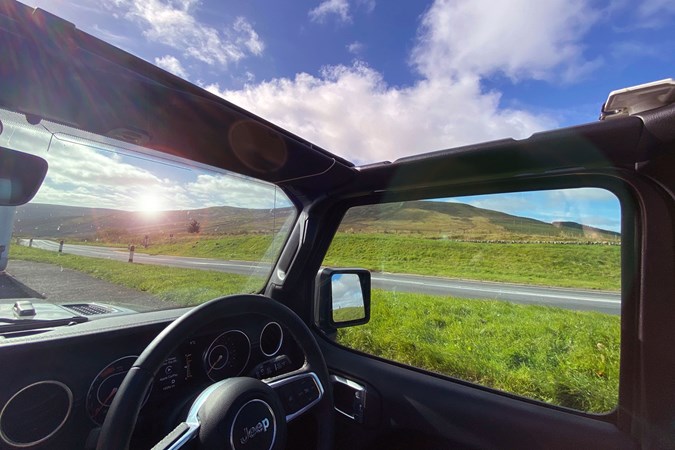
Can’t do that with a Defender (for now).
The sunroof is… well, it might be a big glass panel, but the actual opening is more of a letterbox. You see the front section of glass, how expansive it is, and expect it all to lift up and slide fully back. What you get is a little gap at the front to let wind and noise in, no expansive view out or importantly, readily-available vantage point to stand on the seats and look out of.
It’s too polished. I would not want to take this green laning – everything’s too shiny and pretty.

I would like to take it to Waitrose, when it’s busy so lots of people see me with it, or for a visit to Floors Castle.
Niggles?
Some bits are style over substance. The controls light up – but lack markings when unlit and are not easy to feel and use without looking. And the gear selector with lockout drove me insane – the eight-speed ‘box in the Jeep just has a normal lever, why can’t the Defender? The rotary in the previous Evoque made more sense.
All the checkerplate detailing is purely decorative. The Defender’s got checkerplate-looking bits on the bonnet; the Jeep’s got real hinges, brackets to rest the folded ‘screen on, and you can flip the bonnet right back to the windscreen if you want for easier servicing.
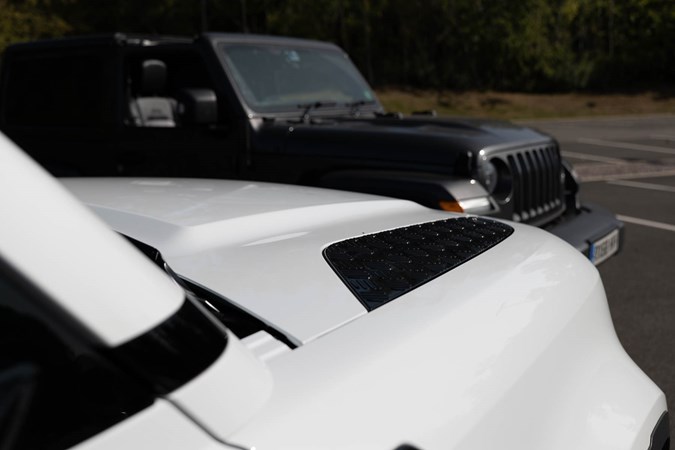

Wrangler’s got plenty of irksome details, but few of them affect operating it and it always goes into drive or reverse when I ask it to. The only issue the Parkers team as a whole keeps coming back to on the Wrangler is the cramped footwell – there’s a big intrusion from the centre tunnel. You definitely notice it after driving other cars, but I’ve never found it a problem even on long drives.
Should I buy a Wrangler or a Defender, then?
You should buy the one you want.
They’re now very, very different vehicles, whereas before the TJ/JK Wrangler and original Defender were competing in the same market. Personally, I would take the Wrangler, but for most families who want a 4x4 – particularly if it’s for the style and attitude and it’s mostly going to be driven on-road – I would recommend the Defender. Well, I’d actually recommend a Discovery Sport if you occasionally need seven seats or an Evoque if you want the kudos of the British marque.
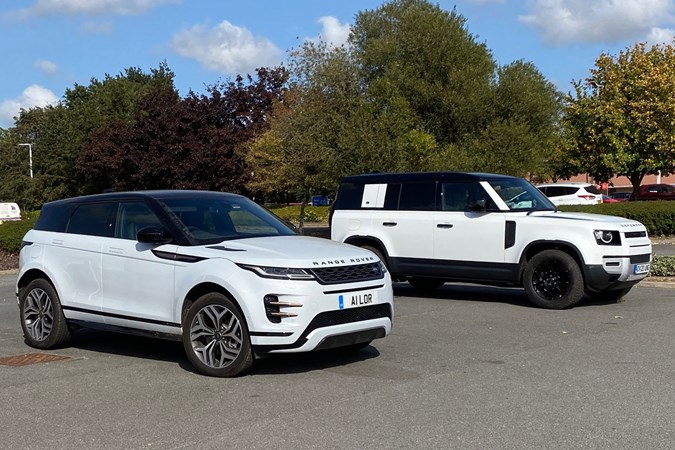
The new Defender is a modern, refined, safe-handling and comfortable, bang up-to-date large family SUV that happens to be styled to resemble a decades-old off-roading legend, whereas the Jeep Wrangler is basically a decades-old off-roading legend with a few padded bits so the kids aren’t too too uncomfortable and the driver can still hear a bit after driving it.
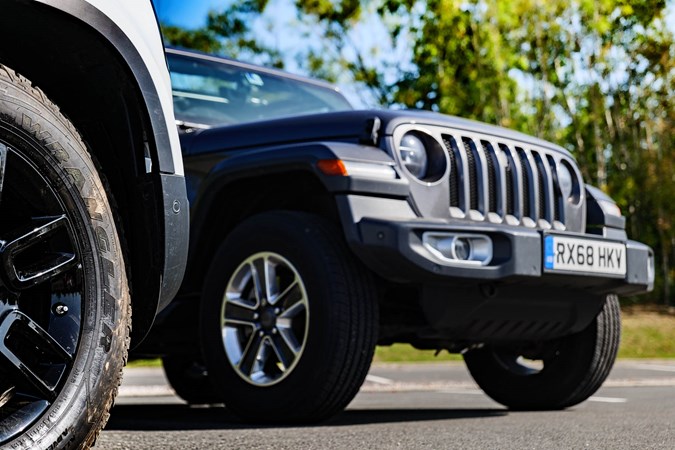
Realistically I should have been pleading to keep the Defender, but I couldn’t wait to get my Wrangler back. Which probably says more than any paragraphs of detailed breakdown ever could.
Footnote: what did Lawrence make of the Wrangler?
‘It made me grin as soon as I left the car park. It’s got the shallow dash and upright windscreen that headbutts bugs out the way, which makes me reminisce my old Defender.
Just having two gearlevers and a handbrake made it feel a little more purposeful and special – it shouldn’t, but given how everything is button controlled nowadays, it’s quite refreshing. Why should I have to applaud myself for using my brain for basic functionality – like tying my shoelace for the fist time in ages, having worn velcro trainers for months.
The gearbox might be a bit clunky at low speeds and the panels rattle non-stop, but there’s no getting away from the way it makes me smile.‘
You’d really pick the Wrangler?
Yes. It may not be rational, but then neither is spending £59,000 on an air-suspended technical tour-de-force that’s trying to look like a vehicle from the 1950s updated. Irrational car purchases are driven by the heart, and the Wrangler is immensely loveable, where the Defender is… what the Discovery should have been all along, and it now seems too cynical, too refined as a workhorse.
Real 4x4 users will buy pickups, Wranglers or old Landies; the Defender is too much of a poser’s car. And that’s coming from someone who would happily commute in a yellow Wrangler Rubicon.
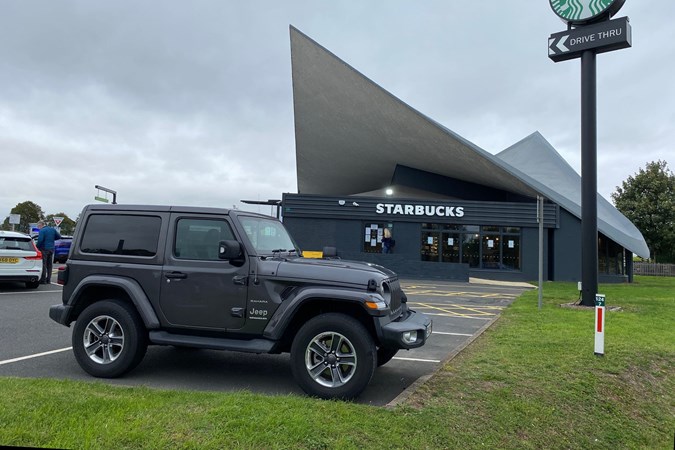
But here’s where it gets interesting. If you gave me a choice between my automotive hero, the Mercedes G-Wagen (in non-AMG form – once a V8 is involved all bets are off), and the Defender… I’d take the Defender now.
| Jeep Wrangler 2.2 Diesel Sahara |
|
| Current mileage | 18,350 |
| Real-world average fuel economy | 34 mpg average |
| Official combined fuel economy (WLTP figures) | 30.1 – 30.7 mpg |
| Parkers ‘MPP’ (Miles Per Pound) calculation | 5.2 – 5.3 |
| Car joined Parkers fleet | July – October 2020 |
Update 4: ‘That’s not my Jeep’
Swapping the Wrangler Sahara for a Wrangler Unlimited Night Eagle with Sky One-Touch roof
Due to 2020’s chaos, L’il Bear had to go back to Jeep before our usual six-month test period (note the 68-plate) – but we really haven’t touched on half of the Wrangler’s abilities. So when I returned to the office, ‘my’ Jeep looked very different.
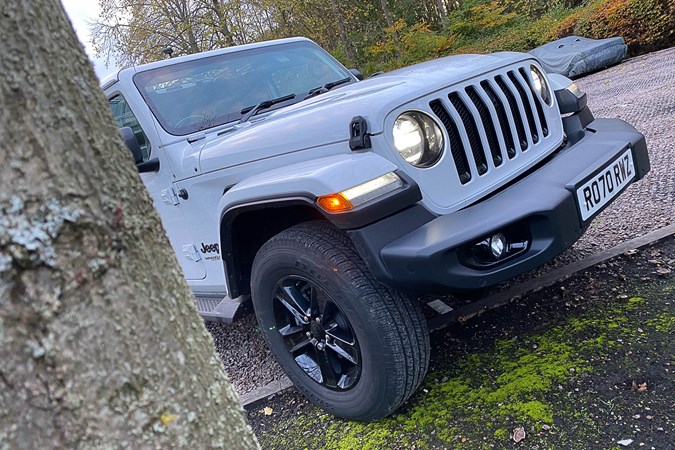
That’s not my Jeep – its roof is too soft.
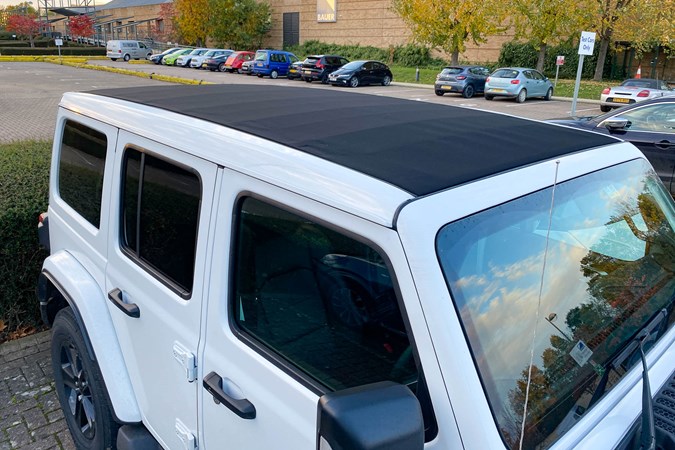
That’s not my Jeep – its sides are too long.
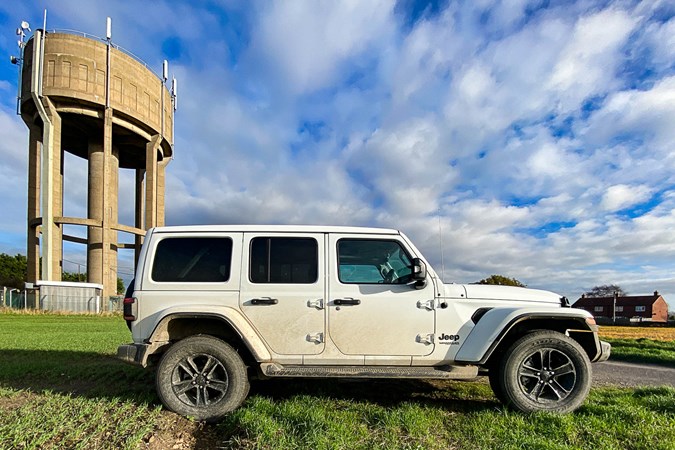
That’s not my Jeep – its paint is too white.
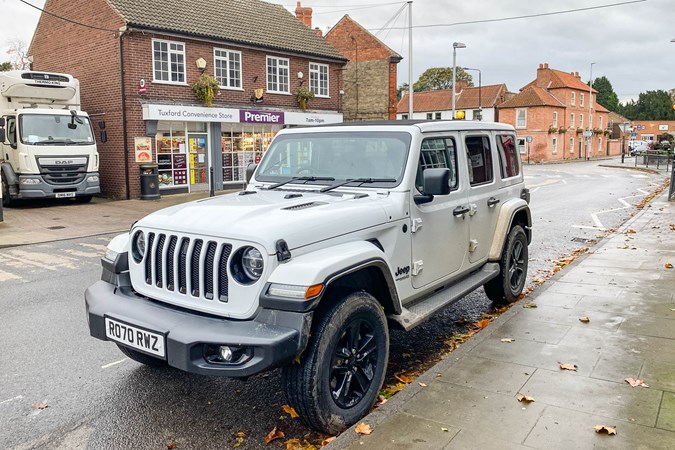
That’s not my Jeep – its purr is too quiet.

Wranglers have been tweaked a little for 2020, but the range is fundamentally unchanged apart from the addition of the Night Eagle specification – which is similar to a Sahara, but includes gloss-black detailing on the grille, lights and interior, and black trim stitching over black leather – but unheated – seats. With all that black, it’s appropriate that this Jeep is finished in shining, gloss…
White. Like a United Nations truck. I take it back, grey would not be my last choice of colour for a Jeep. But then again, it looks good when clean, and shows how much it’s been adventuring when it’s not clean.
Still tempted to cover it in Zebra stripes though.
There are two crucial differences between the grey Wranglers that started this test off. One, it’s equipped with the 272hp turbocharged petrol engine shared with Alfa Romeo. A 48v mild-hybrid, it returns about 6-8mpg less than the diesel in real terms, but with a different, less unpleasant mix of emissions and less noise.
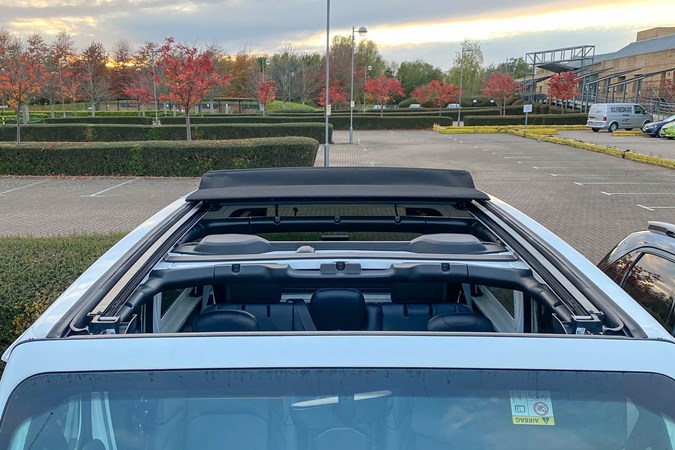
Two, it has the Sky One-Touch roof. This is a fixed hardtop with a full-length sliding fabric sunroof and for Britain, it may be the best roof option for the Wrangler. You don’t need to store the front targa panels in the boot, you can open and close it while driving, and it slides right back, giving the rear passengers a view of the sky as well.
All of those benefits are obvious. What you can’t see is the difference in open-air refinement, as the Sky roof fills in the gaps between the door and the roll cage. There’s so much less wind noise when driving with windows down/roof open it’s like a different car. You can also unclip the rear side windows, but the back hatch glass remains.
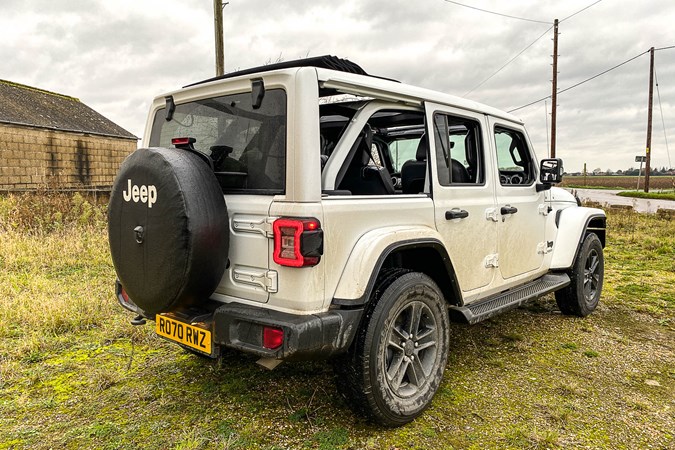
Compared with a Freedom Top, you can:
>> Get open air to every passenger, The folded roof sits above the boot, behind the rear headrest line.
>> Get fully-open sides with small doors, without having to remove a large, bulky hardtop
>> Open the front of the roof while driving, without having to get out and store panels
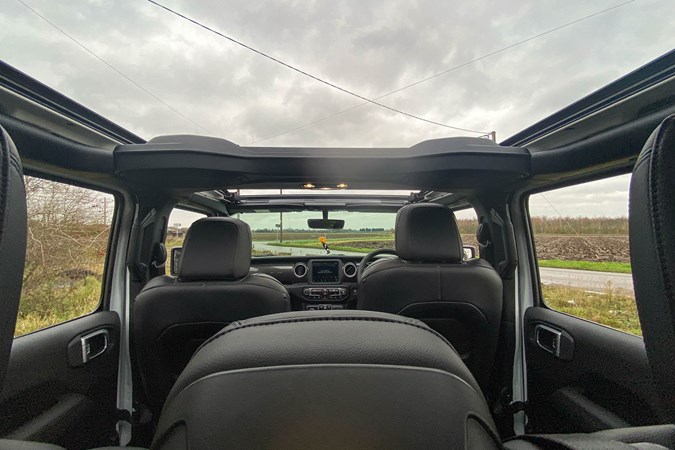
Compared with the folding roof you can:
>> Open it on the move
>> Get a full load of cargo in the back – without having to feed it through a letterbox or unclip side windows
>> Get better security and a top that will look good after a few years even when the Jeep lives outdoors
What you can’t do (officially):
>> Open the windscreen
>> Unbolt the roof for a fully-open Jeep
Unofficially – you can remove the top. It’s brilliantly engineered as a hard top with a sunroof in it and by all reports, quite structurally stable, You can also fold the windscreen, but you need to unbolt the leading edge of the hardtop first and you risk damaging the seals that make the Sky roof so much more refined.
But the thing is, unless you’re a hardcore off-roader, you’ll never need to do these things because even with the roof unbolted on a Jeep, you’ve got a rollcage. The Sky One-Touch roof allows about 80% of a fully-open experience with considerably less hassle – now I’ve used one, I think it’s a much better option than a Freedom top on the four-door Wrangler.
So where you might often look at the hardtop on your regular one, wanting to get more of an ‘open’ feel, with the Sky One-Touch roof you’ll just open the roof and windows, unclip the side windows (they have a carry bag like the targa roof panels) and enjoy the open-air feeling without worrying about what you’ll do if it rains.
If it had a quick-release system for the tailgate glass it would be perfect.
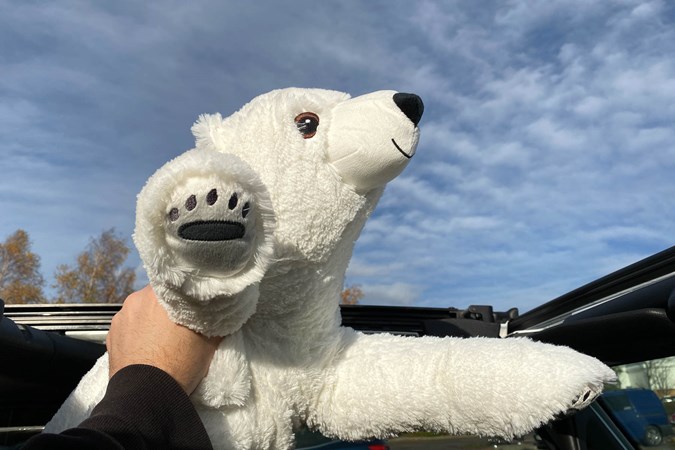
Update 5: cooking on gas(oline), driving the 2.0-litre petrol Wrangler
British sensibilities want diesels in 4x4s. It’s an attitude shaped by common sense – a 2.25 ‘Series’ petrol Land Rover would struggle to do 70mph and deliver 9mpg in the process, the V8-powered Discovery and Range Rover were hideous on fuel, and when Jeep introduced the Cherokee to the UK, 1990s buyers reeled away from from the 4.0-litre straight-six, straight into the multiple heads of the VM Motori 2.5-litre diesel four-cylinder.
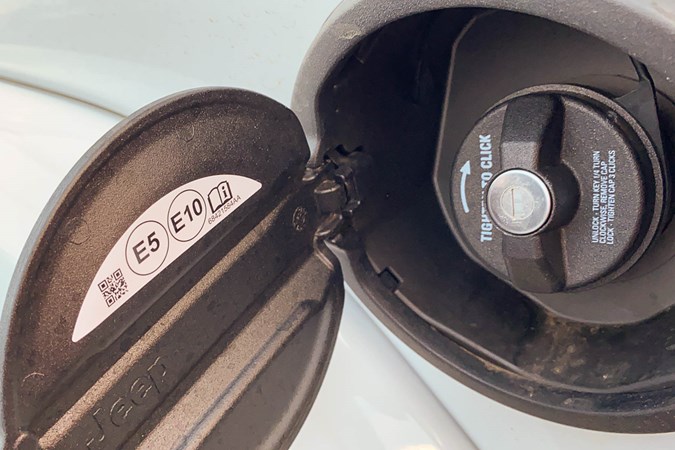
But here’s the thing – my old Cherokee did 28mpg routinely, despite being as rapid as a typical hot hatch of that era. The fuel that goes in relates to the speed you get out – drive a modern petrol 4x4 at the speeds the diesel is comfortable at, and the gap in economy falls.
So while we don’t get the petrol V6 (or recently-announced V8) in UK Wranglers, what about that 272hp turbo petrol?
First of all, it’s quieter than the diesel, but it’s not a particularly characterful or refined engine in that you can hear it a bit, but it never really makes a noise worth remembering. The kindest thing to say about how it sounds is that it has a hint of the old ‘Go-Devil’ engine you hear in WWII Jeep films, but that’s a stretch. It’s definitely smoother than the diesel and much, much nicer at idle too.
It makes enjoying peaceful, quiet spaces a lot more… well, peaceful.
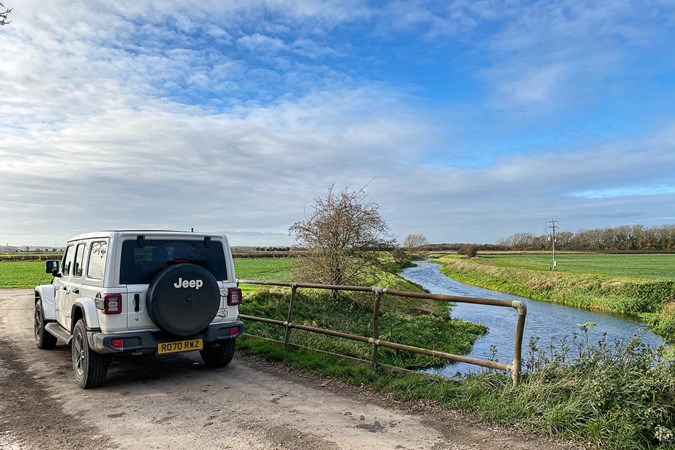
Where you notice the difference most is under your right foot. The extra power and higher-revving nature of the engine allows the Wrangler to overtake with remarkable confidence, and passing HGVs and tractors safely is a joy. The handling is unchanged, so don’t expect a sporty, precise drive, but the power and gearing means even the heavier four-door Unlimited can pass a slower lorry as safely as a typical 2.0 diesel car would.
Aside from the fuel economy there really are no downsides to the 2.0-petrol, and for the sake of around 6mpg difference the benefits far outweigh the costs. With no AdBlue system to worry about further down the line, it’s arguably the better option for long-term ownership too.
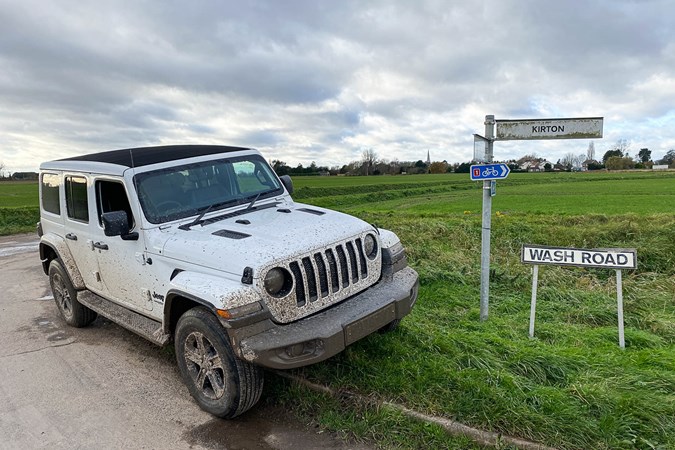
| Jeep Wrangler Unlimited 2.0 Petrol Night Eagle |
|
| Current mileage | 3,380 |
| Real-world average fuel economy | 28.8mpg average |
| Official combined fuel economy (WLTP figures) | 25 mpg |
| Parkers ‘MPP’ (Miles Per Pound) calculation | 4,4 |
| Car joined Parkers fleet | November 2020 |


